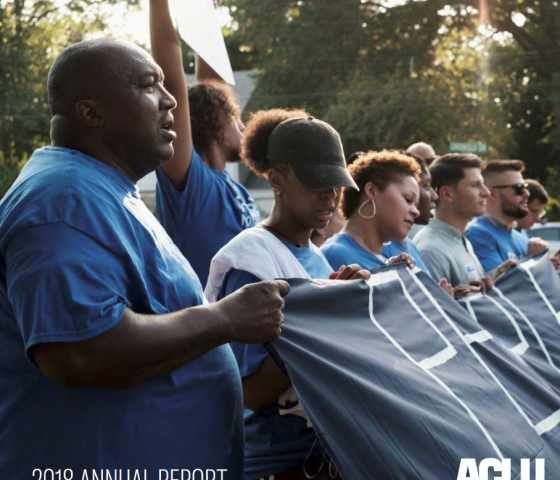The right to vote in a democratic election is a linchpin of any free society. Measures that make voting easier, such as election day voter registration, universal voter registration, early voting, and expanded voting by mail, allow more people to vote. When we make voting more accessible, we all benefit.
We all know this – it’s common-sense. Yet despite the clear benefits to making voting easy and accessible, the state of Connecticut has far too many barriers to voting, even in normal times. As we grapple with COVID-19, though, Connecticut’s limits on voting now threaten people’s health in addition to their rights.
Connecticut is third nationwide in the number of COVID-19 deaths per capita. The most populous counties in the state are among the worst in the country for total coronavirus deaths. Early evidence also suggests that the virus is taking Black, Latinx, and Native lives in disproportionate numbers nationwide – not for any biological reason, but because of institutional and systemic racism.
The state appears to be on track for reopening on May 20, though public health experts warn that unless states meet key criteria, premature reopening could result in a resurgence and longer pandemic. Even with optimistic estimates, some public health experts believe that social distancing and isolation will be necessary well into 2021 or even 2022. In short, Connecticut has been very hard hit by COVID-19, and the hard truth is that no one really knows when the pandemic will end.
Connecticut voters, meanwhile, are deeply concerned about having to vote in-person for the primary and general elections. On April 30, more than 50 Connecticut organizations called on the state to allow absentee voting and online absentee ballot applications, stating that making voters choose between voting and their health is “unconscionable.” Secretary of the State Denise Merrill has acknowledged that voters are “panicked” over making this choice.
Limiting the ways for people to vote, and thereby forcing people to choose between protecting their health and voting in person, could also particularly jeopardize Black and Latinx voters’ health and access to the ballot box. Historically, long lines at the polls have undermined voters’ rights in majority Black and Latinx neighborhoods in Bridgeport, Hartford, and other places around the state. A crowded polling place can threaten people’s rights to vote during normal times; it could threaten their right to vote and their health during a pandemic.
Despite issuing more than three dozen emergency orders related to COVID-19 since March 12, Governor Lamont has not acted to make voting safe for Connecticut voters. Instead, he has pushed off the decision or cancelled voting entirely. He twice pushed back the state’s presidential primary in light of the pandemic, moving it from April 28, 2020 to June 2, 2020, and then moving it again to its current date of August 11, 2020. Rather than seeking a vote-by-mail solution, the Governor also mandated that towns suspend the rights of voters to vote on budgets and mill rates for 2020-2021.
The solution does not have to be difficult. One critical piece of that solution is increasing Connecticut voters’ abilities to vote absentee by mail, something many public health experts say is a critical option to enable people to fully socially distance. Connecticut has had absentee voting by mail for many years, and expanding the number of people voting by mail doesn’t increase the chance of fraud because the same safeguards are in place. Indeed, the idea that voting by mail increases instances of voter fraud – an already extremely rare occurrence – has been debunked, as has the idea that any particular party benefits from voting by mail.
Without any legitimate concerns, there is no reason not to implement widespread absentee voting in Connecticut. While the state does not have what’s known as no-excuse absentee voting (which allows anyone to vote absentee by mail for any reason), Connecticut’s Constitution does provide for absentee voting “because of sickness.” The legislature enacted laws to flesh out the process for absentee voting, but in doing so it failed to use the exact language of the Constitution, instead seemingly limiting absentee voting. The statutes currently provide that an eligible voter may vote by absentee ballot because of “his or her illness.”
In light of the pandemic, an executive order or legislative act need only strike the words “his or her” to allow for absentee voting due to widespread illness. An executive order would require only action from Governor Lamont, who has already issued emergency orders overriding certain statutory provisions; he should do it in this limited instance as well. The legislature could address this straightforward fix in a special session in advance of this year’s elections.
These changes should not be limited to the August primary, either. Critical elections at the local, state, and federal level are happening in November. Without a clear idea of when the pandemic will end, it is necessary to take steps now to make sure that everyone who wants to cast a ballot in November is able to do so.
Expanding absentee voting for widespread illness in the state is a simple and important part of protecting voting rights. It is not too late to protect the franchise for the people of Connecticut during this pandemic. People should not have to choose between exercising their right to vote and remaining safe from a highly infectious disease. Governor Lamont and the General Assembly should act to ensure that no one in Connecticut is forced to make this inexcusable choice.





